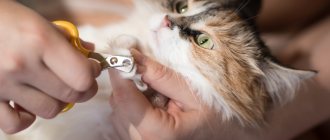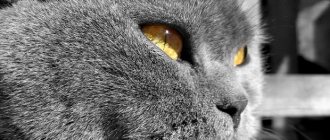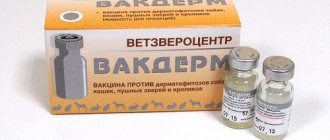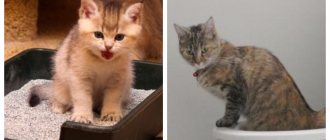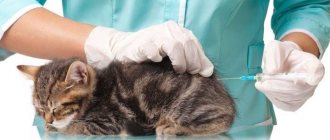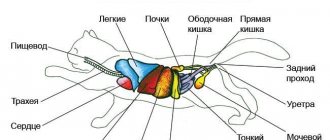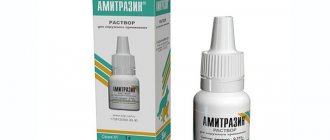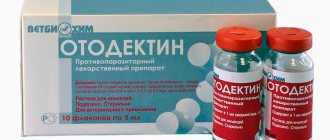Cystoisosporosis in cats
– a parasitic disease caused by infestation of an animal by protozoa from the family
Eimeriidae of the genus Cystoisospora.
The genus
Cystoisospora
is species-specific (the pathogen species to which cats are susceptible cannot parasitize dogs, and vice versa):
Cystoisospora canis, C. ohioensis and C. burrowsi
usually infect dogs.
Cystoisospora felis
and
C. rivolta
affect cats. Isosporosis can also affect humans, however, the type of pathogens is different from those in dogs and cats, so infection with this disease does not occur from pets.
Isosporosis in cats
occurs when sporulated (mature) oocysts enter the cat’s body through the fecal-oral route (entry into the digestive tract of feces or its fragments containing mature spores of the pathogen).
The parasite passes through all intestinal stages of development inside the intestinal epithelial cells, destroying them in the process, which largely determines the clinical symptoms
. The release of spores in feces begins 6-10 days after infection; in order for the spores to “ripen” and become infectious, they must remain in the environment for some time.
Source of isosporosis
In the wild, cats are rodents, although many vertebrates can be intermediate hosts.
By eating raw meat from infected animals, cats and dogs can also become infected with isosporosis. The active period of oocyst excretion in feces after primary infection is on average 5-10 days. If reinfection occurs (the cat re-ate its own oocysts), then the isospores are distributed throughout the organs and tissues of the animal, and chronic, often asymptomatic carriage
.
The type of diet also plays a role, because the intermediate hosts and reservoirs of cystoisospores are rodents, in which the parasites go through several stages of reproduction in the lymphoid organs, liver and muscles. Accordingly, a cat who spent the summer free-ranging in the countryside is much more likely to encounter isospores than a domestic Yorkshire terrier. According to literature data,
under 6 months of age
are most susceptible to the disease . Infection of puppies and kittens can occur not only when eating mouse-like rodents, but also when oocysts of the pathogen enter from a mother with asymptomatic isosporosis, contaminated food or water. It should also be taken into account that isosporosis is a widespread disease, and the oocysts themselves are very stable in the external environment, where they can persist for months in the same area.
Severity of the disease
depends on the amount of isospores that enter the animal’s body.
Sometimes owners may not even realize that their pet is sick. But in stressful situations for the body, isosporosis begins to progress and manifest itself with clinical signs such as frequent defecation of unformed feces with a large amount of mucus and streaks of blood, loss of appetite, and anorexia.
Since the favorite place of isospores in the body of dogs and cats is the intestinal epithelium, other
symptoms of enterocolitis
, complicated by the proliferation of secondary bacterial microflora.
Diagnosis of cystoisosporosis is carried out in a veterinary laboratory after contacting a veterinarian! For the study, fresh feces are taken, collected in the cleanest possible conditions and in a special container, which can be purchased in human pharmacies. If a cat uses a litter box, the owners must clean the biomaterial from the litter, otherwise the laboratory may refuse to conduct the test. After the course of treatment, a stool test is also taken (sometimes several samples are required - up to 3 negative results) to confirm the effectiveness of the prescribed course.
Treatment
cystoisosporosis, taking into account the sensitivity of the pathogen to antibacterial drugs of the sulfonamide and nitrofuran series, as well as eimeriostasis,
should be complex and long-lasting
. In addition to the above drugs, the combined use of gastroprotectors to protect the mucous membrane of the gastrointestinal tract, broad-spectrum antibiotics and metronidazole to suppress secondary bacterial microflora, antispasmodic and adsorbent drugs as symptomatic therapy and probiotic drugs to normalize intestinal microflora is recommended. For anorexia and dehydration, subcutaneous or intravenous infusions of solutions and vitamins are recommended.
It is advisable to disinfect places of detention and care items using alkaline solutions. In areas where cases of isosporosis have been reported, exclude free walking of dogs and cats and the possibility of them eating rodents or plants on which oocysts of the pathogen may remain.
Under no circumstances should animal owners self-medicate
. Similar symptoms in cats and dogs can be caused by other pathogens of a protozoal, bacterial or viral nature, nutritional factors, etc., therefore only a veterinarian, after examination, can offer the correct diagnostic methods and appropriate treatment. Also, you should not stop already prescribed treatment after the disappearance of clinical signs of the disease, because the life cycle of the parasite in the body of infected animals can last more than 11 days.
If your animal shows signs of cystoisosporosis, we are always happy to see you at the VetState veterinary clinic 7 days a week, 365 days a year from 10.00 to 21.00. For
more detailed information, you can contact the multi-line phone.
Disease of the digestive system and intestines is unpleasant not only for humans, but also for animals. The danger and problem is that the animal does not speak and it is very difficult to diagnose the disease. After all, cats have several dozen diseases of the stomach and digestive tract; often the symptoms coincide and it is extremely difficult to determine the disease without the intervention of a doctor. Under no circumstances should you engage in diagnosis and treatment on your own, because by choosing the wrong course of treatment, the owner not only exposes the pet to new problems, but also aggravates the old ones. For example, isosporosis in cats is considered a fairly serious problem that requires close attention and must be treated carefully.
Our veterinarian provides a home call service. This is not only convenient for the owner in terms of saving time, but also beneficial for the animal. After all, moving to clinics, and even with pain in the stomach and intestines, will not have a beneficial effect on them. Due to the fact that our center has several reference points in Moscow and the Moscow region, the veterinarian arrives within an hour. He always carries the necessary tools and documents with him in the car. Therefore, right during the departure, a diagnosis will be carried out, and then a course of treatment will be immediately prescribed that will help the pet return to its usual lifestyle.
Isosporosis in cats: the pathogen and its danger
Isospora disease in cats is caused by two protozoan parasites: Isospora rivolta and I.felis . These organisms are simple and single-celled and live in the intestines of cats and other domestic animals. Moreover, there are frequent cases of infection in humans
, but human parasites include more specific subspecies of the pathogen.
If we talk about age, then
younger individuals aged from six months to a year
are susceptible The disease also often occurs in older pets and already weak animals.
Isosporosis in cats: diagnosis and treatment
Of course, only an experienced veterinarian can prescribe treatment for such a disease.
, already facing symptoms and consequences. He prescribes a comprehensive course to restore the pet. Of course, this includes etiotropic therapy (when the cause of the disease itself is treated, for example, with the help of antibiotics and antibacterial agents) and symptomatic treatment. This includes the treatment of organs and those body systems that have been damaged. Also, due to dehydration, bed rest and IV drips are often prescribed. If the vomiting is particularly severe, then these are antiemetics. If blood appears during bowel movements, it means there is bleeding in the gastrointestinal tract and blood-stopping agents must be used. If diarrhea is particularly severe, then special means are used that bind feces inside the animal and restore this function. And so on, as you can see, there are many ways and they vary, of course, depending on the individual characteristics of the organism.
Separately, it is worth highlighting the dehydration of a sick pet, which is done by a veterinarian using intravenous injections of various minerals, vitamins and products that remove all harmful toxins from the body and restore the animal’s water balance. Ringer's solutions, glucose, and other drugs are administered intravenously to relieve intoxication and eliminate signs of dehydration in the animal.
If you suspect isosporosis in cats, you should also check:
- In addition to these medications, animals are also prescribed the following, but this, again, depends on the individual characteristics of the animal:
- Of course, antibiotics that relieve inflammation in the gastrointestinal tract. They are taken for no more than two weeks, depending on the stage of the disease.
- Diets to restore the intestines and their work.
- Intravenous drips to restore water balance and nourish the animal if it is constantly vomiting.
- Antispasmodics to relieve your pet of intestinal pain.
If diseases are detected in time, then there is no need to talk about death, because the animal quickly recovers with proper care and treatment, even if it is a kitten, a sick or old animal. However, it happens that even with seemingly correct steps, there is no improvement, or it is not so significant. Then the veterinarian should check the following:
- Does the pet have a disease that occurs in parallel or were the symptoms confused and the diagnosis was made. The following is checked:
- Panleukopenia.
- Coronavirus enteritis.
- Giardiasis.
- Worms.
- Toxoplasmosis.
- Intolerance in the intestines.
- Cryptosporidiosis or infection with other bacteria.
Onset of the disease, symptoms
About 13 days pass from the moment of infection to the appearance of the first clinical signs. This is why kittens initially look completely healthy. Because of this, many breeders believe that the culprit of isosporosis is another animal or person who introduced the infection. Of course, this also happens, but if your pet’s kittens suddenly become ill with isosporosis, you should take their mother to the clinic and check the animal’s feces for the presence of cysts of the pathogen.
The symptoms of isosporosis in cats themselves are very monotonous: the disease manifests itself with profuse diarrhea, and the feces look watery and somewhat mucous. The mucus is understandable: it is the release of millions of dead intestinal epithelial cells. Bloody diarrhea and vomiting indicate the progression of the pathology. But it's not diarrhea that you should worry about, it's severe dehydration. Its consequences are extremely serious. In severe cases, it is fraught with severe neurological seizures.
Important! Note that small kittens with coccidiosis can rarely survive longer than two days, so it is better not to delay contacting a veterinary clinic. Weak and old cats can also die. In any case, constant diarrhea will definitely not improve the health of their body.
By the way, do the causative agents of feline isosporosis pose any danger to humans? Purely hypothetically, no. The fact is that people have specific types of these parasites. But from a practical point of view, the question is somewhat more complicated. No, you are unlikely to experience “full-fledged” isosporosis when interacting with a sick cat... If you wash your hands. But it is still very advisable to isolate a sick cat from infants and the elderly. Their immunity is weak, and the likelihood of a serious intestinal disorder (theoretically) exists. So it's better not to take risks.
Isosporosis in cats: prevention
First of all, it is necessary to isolate the cat from healthy pets and also people. After all, it is capable of infecting anyone and then the consequences will be even more dire. It is worth doing tests on everyone who came into contact with the cat, because feces may contain cysts that have not yet begun to act.
It is also, of course, important to take the cat out into the fresh air and feed it with a variety of high-quality food and food, so that the immune system is strong and there are no reasons to get sick, even if the cysts are already in the body. To find out if they exist, you should have your stool analyzed every six months or a year, for confidence and prevention.
Giardiasis
The disease is caused by Giardia canis. Infection occurs with water and food. Giardia does not live inside cells, attaching to the intestinal villi from the outside.
Carriage of these parasites is often asymptomatic. But pathogenic strains cause diarrhea and interfere with digestion. Then the chair becomes:
- liquid;
- smelly;
- mixed with mucus and blood.
A scatological examination (using the Fulleborn or Darling method) is carried out three times, every 2-3 days, since oocysts are not released regularly or in insufficient quantities.
To diagnose giardiasis, there is a rapid test (the answer will be in 5-10 minutes), feces are examined using the ELISA method.
We suggest you familiarize yourself with: First aid for cats
Symptoms
Isosporosis
with clinical manifestations most often occurs in kittens from four weeks to three to four months. The source of infection is usually their mother. In kittens, the disease can occur with the following symptoms:
But most often the disease is asymptomatic and does not require any treatment, and isospores become an accidental finding during diagnosis.
Isosporiasis is rare in adult cats. The symptoms are similar to infection with any other protozoa (giardiasis, toxoplasmosis) - owners of adult animals complain of dull fur, unformed stools and decreased condition (thinness).
All of the listed symptoms are not specific, and can be signs of a wide range of different pathologies, so for diagnosis it is necessary to consult a veterinarian, and laboratory tests will definitely be required. Treatment will vary significantly depending on the causes of the condition.
How does leptospirosis develop?
Once the parasite is ingested, the pet becomes a carrier for 3-4 months. During this time, pathogenic cells are able to multiply while in a comfortable living environment. They actively divide, penetrate into the blood, intestines, and onto the surface of the liver and kidneys. Such vital activity leads to irreversible damage to the pet’s internal organs.
Then damage to the eyes and nerve cells begins. Yellowing appears on the sclera, and ulcers appear on the eyelids, nose, and mouth. The patient's coat looks very bad.
The cat's general condition is deteriorating: he moves less and less and does not eat anything. Most often, an animal close to a coma refuses water. In this case, you need to give him liquid little by little through a syringe. If the animal is unable to swallow, it must be hospitalized immediately.
It all ends in severe intoxication of the body. The cat vomits bile and stomach acid for a long time and painfully. Vomit has an unpleasant odor. During this period, the animal can no longer get up. The only thing that can save him is placement in a hospital and intensive therapy.
Treatment
As for the treatment of isosporosis, you need to remember that treatment is aimed at getting rid of the symptoms of the disease - diarrhea, poor weight gain, and not at obtaining a stool test negative for cytoisospores, since animals can live with isosporosis and not show any concern. Many regimens and various drugs are used for treatment. The most used ones are:
- Sulfonamide + trimethoprim (“Biseptol” and its analogues) – daily, for 5 days.
- Sulfadimethoxine – daily for 10 days.
However, sulfonamides can cause anemia associated with cyanocobalamin deficiency in some cats, therefore, when treating with the medications mentioned above, the animals should also be given a course of vitamin B12.
Recently, Toltrazuril has been most often used to treat isosporosis:
- "Baycox" 5% - daily, once a day for 3 days.
The drug is dissolved in yogurt or non-acidic cottage cheese and given to the cat.
In addition to the listed drugs, animals are also prescribed:
-
Antibiotics
- to relieve the inflammatory process in the intestines - for a course of 7-10-14 days, depending on the severity of symptoms. - Diets for the gastrointestinal tract
- for faster restoration of intestinal function. - Intravenous drips
- in case of lack of appetite, vomiting or severe dehydration in the animal. - Antispasmodics
– for pain or discomfort in the animal in the intestinal area. - Hemostatic drugs
- in the presence of blood in the stool, antiemetics - in the presence of vomiting, etc.
Isosporosis is usually easy to treat and is not a disease with a high probability of death. If a cat or kitten does not show positive dynamics with adequately prescribed therapy, then the veterinarian should first find out whether the cat has a concomitant (or perhaps an underlying) disease with the same symptoms, namely:
- Panleukopenia;
- Coronavirus enteritis;
- Giardiasis, cryptosporidiosis, infection with amoebas or other protozoa;
- Worm infestation;
- Food intolerance;
- Toxoplasmosis
It may also be advisable to clarify whether the owner is following the prescribed therapy. Since all drugs used to treat isosporosis have a bitter taste, it is quite difficult to give them to cats. Some owners cannot give the drug to the cat, give only part of the dosage, or do not complete the full course (for example, give 3 days instead of 5), which, of course, does not lead to a positive result.
Features of oocysts
In appearance, oocysts are bodies up to 33x19 microns in size, oval in shape, at the end of which there are two ends, slightly narrowed. Oocysts have a pale, smooth shell. Such isosporosis pathogens can even live in the soil for a long time before they enter the human or animal body.
We invite you to read: How cats are sterilized by puncture, its advantages and price
But isospore in the body does not always cause illness and leads to disruption of the gastrointestinal tract. Often people, cats, and dogs are simply carriers of such a pathogen for a long time. If a cat has a strong immune system, its physical condition will not change. But the situation is completely different with pets that are weakened by long-term illnesses or have a weak immune system from birth.
In this case, the oocysts begin to actively influence the body. What happens to a kitten or weak adult animal? His digestion process is significantly disrupted, and also, which is no less dangerous, nutrients are not absorbed correctly.
Recommendations
To prevent isosporosis, it is necessary to maintain cleanliness in the room where the cat lives. To treat a room from isospores, chlorine-containing detergents are usually used; hot steam treatment also works well.
To prevent epidemics, nurseries and shelters must be kept clean, wet cleaning must be carried out daily, and animals must have their own bowls and individual toilets.
If your cat has had isosporosis, it is important to know that for some time it will be a source of infection, so do not introduce it to other animals and practice only indoor keeping.
Transmission routes
It must be emphasized that protozoa cannot overcome the placental barrier, and indeed, they live exclusively in the intestines. Therefore, even a cat whose intestines are full of pathogens gives birth to healthy kittens (of course, if the mother does not show clinical signs).
Attention! Infection occurs very quickly: the cat constantly licks itself, keeping its fur clean, and the cysts are spread over the entire surface of the body, including landing on the animal’s nipples. When kittens feed, infection occurs. In young animals the course of the disease is very severe. Often young animals (especially in animal shelters) die from severe dehydration, which in some cases develops within a couple of hours.


